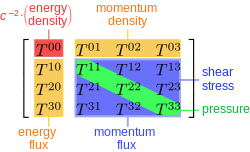Fluid fully characterized by its density and isotropic pressure
 The stress–energy tensor of a perfect fluid contains only the diagonal components.
The stress–energy tensor of a perfect fluid contains only the diagonal components.
In
mass density

and
isotropic is the closest known substance to a perfect fluid.
In space-positive metric signature tensor notation, the stress–energy tensor of a perfect fluid can be written in the form

where U is the 4-velocity vector field of the fluid and where  is the metric tensor of
is the metric tensor of
Minkowski spacetime
.
In time-positive metric signature tensor notation, the stress–energy tensor of a perfect fluid can be written in the form

where U is the 4-velocity of the fluid and where  is the metric tensor of
is the metric tensor of
Minkowski spacetime
.
This takes on a particularly simple form in the rest frame
![{\displaystyle \left[{\begin{matrix}\rho _{e}&0&0&0\\0&p&0&0\\0&0&p&0\\0&0&0&p\end{matrix}}\right]}](https://wikimedia.org/api/rest_v1/media/math/render/svg/875c5a58c98b9d041855127d579206c801800fe0)
where  is the energy density and
is the energy density and  is the pressure of the fluid.
is the pressure of the fluid.
Perfect fluids admit a Lagrangian formulation, which allows the techniques used in field theory, in particular, quantization, to be applied to fluids.
Perfect fluids are used in
Friedmann–Lemaître–Robertson–Walker
equations to describe the evolution of the universe.
In general relativity, the expression for the stress–energy tensor of a perfect fluid is written as

where U is the 4-velocity vector field of the fluid and where  is the inverse metric,
written with a space-positive signature.
is the inverse metric,
written with a space-positive signature.
See also
References
- The Large Scale Structure of Space-Time, by S.W.Hawking and G.F.R.Ellis, Cambridge University Press, 1973. (pbk.)
- WA Zajc (2008). "The fluid nature of quark–gluon plasma". Nuclear Physics A. 805 (1–4): 283c–294c. .







![{\displaystyle \left[{\begin{matrix}\rho _{e}&0&0&0\\0&p&0&0\\0&0&p&0\\0&0&0&p\end{matrix}}\right]}](https://wikimedia.org/api/rest_v1/media/math/render/svg/875c5a58c98b9d041855127d579206c801800fe0)



